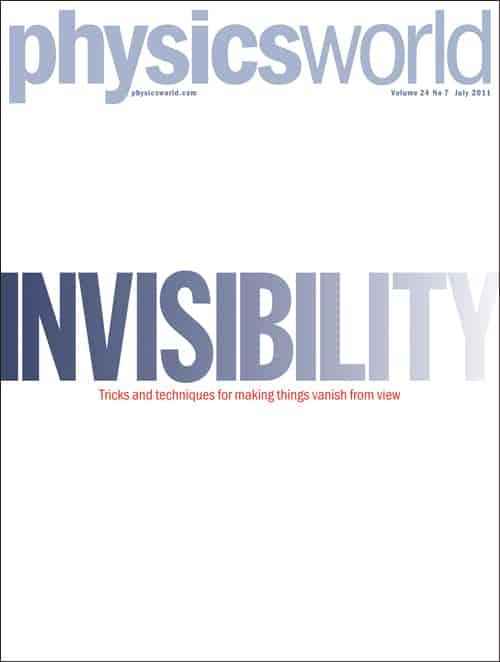By Matin Durrani

It is perhaps a little-known fact that Griffin – the main character in H G Wells’ classic novel The Invisible Man – was a physicist. In the 1897 book, Griffin explains how he quit medicine for physics and developed a technique that made himself invisible by reducing his body’s refractive index to match that of air.
While Wells’ novel is obviously a work of fiction, the quest for invisibility has made real progress in recent years – and is the inspiration for this month’s special issue of Physics World, which you can download for free via this link.
Kicking off the issue is Sidney Perkowitz, who takes us on a whistle-stop tour of invisibility through the ages – from its appearance in Greek mythology to camouflaging tanks on the battlefield – before bringing us up to date with recent scientific developments.
Ulf Leonhardt then takes a light-hearted look at the top possible applications of invisibility science. Hold on to your hats for invisibility cloaks, perfect lenses and the ultimate anti-wrinkle cream.
Some of these applications might be years away, but primitive invisibility cloaks have already been built, with two independent groups of researchers having recently created cloaks operating with visible light that can conceal centimetre-scale objects, including a paper clip, a steel wedge and a piece of paper. But as Wenshan Cai and Vladimir Shalaev explain, these cloaks only work under certain conditions, namely with polarized light, in a 2D configuration and with the cloak immersed in a high-refractive-index liquid. It seems that the holy grail of hiding macroscopic objects viewed from any angle using unpolarized visible light is still some way off.
The special issue ends with a look at something even more fantastic-sounding – the possibility of creating a cloak that works not just in space but in space–time. Although no such “event cloak” has yet been built, Martin McCall and Paul Kinsler outline the principles of how it would work and describe what might be possible with a macroscopic, fully functioning device that conceals events from view. These applications range from the far-fetched, such as the illusion of a Star Trek-style transporter, to the more mundane, such as controlling signals in an optical routing system.
But, hey, that’s enough of me banging on about the special issue. Download it for free now and find out for yourself. And don’t forget to let us know what you think by e-mailing us at pwld@iop.org or via our Facebook or Twitter pages.
P.S. If you’re a member of the Institute of Physics, you can in addition read the issue in digital form via this link, where you can also listen to, search, share, save, print, archive and even translate individual articles. How’s that for value?



